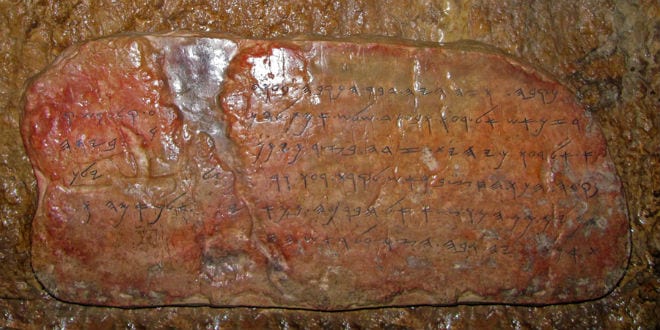After years of dispute, Turkey agreed to return the Siloam Inscription, considered to be one of the most important ancient Hebrew inscriptions in existence. that has been in Istanbul Archaeology Museum. The announcement comes in the wake of a one-day visit to Istanbul by President Isaac Herzog.
The Times of Israel reported cited a Turkish official as saying that Israel offered to reciprocate by sending Turkey a valuable historical and religiously significant item currently housed in an Israeli museum, most likely an ancient candelabra from the days of Ottoman rule. The deal was not discussed during the talks between Herzog and Turkish President Recep Tayyip Erdogan, but was negotiated by senior officials on both sides. The Times of Israel report stated that there was no immediate confirmation from Turkey. It is believed that the return of the inscription signals improved relations between Israel and Turkey
The stone, inscribed with Paleo-Hebrew letters dated to the eighth century BCE, is one of the oldest extant records of its kind. It was found in the Shiloah Tunnel in Jerusalem in 1880. In 1890, a resident of Jerusalem stole the inscription from the wall of the tunnel. During this work the inscription cracked into six to seven pieces and several letters were injured at the breakpoints. The Ottoman government recovered the inscription and had it installed in the Istanbul Museum. The inscription records the construction of the tunnel; according to the text the work began at both ends simultaneously and proceeded until the stonecutters met in the middle.
The inscription’s significance is undeniable: it confirms the Biblical account of a Jewish king constructing the existent water system in Jerusalem. The construction of the conduit was an important factor in safeguarding the mountaintop city’s only source of water against an imminent attack by the Babylonian King Sennacherib. It was a remarkable feat of engineering for its time, requiring four years to complete. Two teams dug through solid stone from opposite ends, finally meeting in the middle.
The tunnel is described in the Book of Kings:
Now the rest of the acts of Chizkiyahu, and all his might, and how he made the pool, and the conduit, and brought water into the city, are they not written in the book of the chronicles of the kings of Yehuda? II Kings 20:20
The passage reads:
- … the tunnel … and this is the story of the tunnel while …
- the axes were against each other and while three cubits were left to (cut?) … the voice of a man …
- called to his counterpart, (for) there was ZADA in the rock, on the right … and on the day of the
- tunnel (being finished) the stonecutters struck each man towards his counterpart, ax against ax and flowed
- water from the source to the pool for 1,200 cubits. and (100?)
- cubits was the height over the head of the stonecutters …
Multiple requests by Israeli diplomats for the return of the Siloam Inscription have been rebuffed. Most recently, in 2017, Miri Regev, Israel’s Minister of Culture and Sport, was in Gaziantep accompanying an Israeli basketball team for their match against a Turkish team. The day after the game, Regev had an informal meeting with the mayor of the city, Fatma Sahin. During the conversation, Sahin mentioned that the city’s zoo was suffering from a pachyderm problem: they only had one elephant and wanted more.
The Turkish mayor said jokingly, “We’re willing to work for it.”
A native Israeli used to bargain in the open-air shuk, Regev jumped on the opportunity. Via a translator, she said to Sahin, “We’ll make a deal. We’ll give them two elephants, and they’ll give us the inscription of Hezekiah.”
In 1998, Prime Minister Benjamin Netanyahu offered to trade Turkish antiquities in Israeli museums for the precious Hebrew inscription, but his offer was rejected.
Another request in 2007 by former President Shimon Peres to borrow the inscription for a short period was initially accepted by the Turkish president Abdullah Gül, but the loan never materialized.
In 2007, Jerusalem Mayor Uri Lupolianski met with Turkey’s ambassador to Israel, Namık Tan, and requested that the tablet be returned to Jerusalem as a “goodwill gesture.”Turkey rejected the request. President Abdullah Gul said that Turkey would arrange for the inscription to be shown in Jerusalem for a short period, but this has yet to happen.
The shortcode is missing a valid Donation Form ID attribute.




